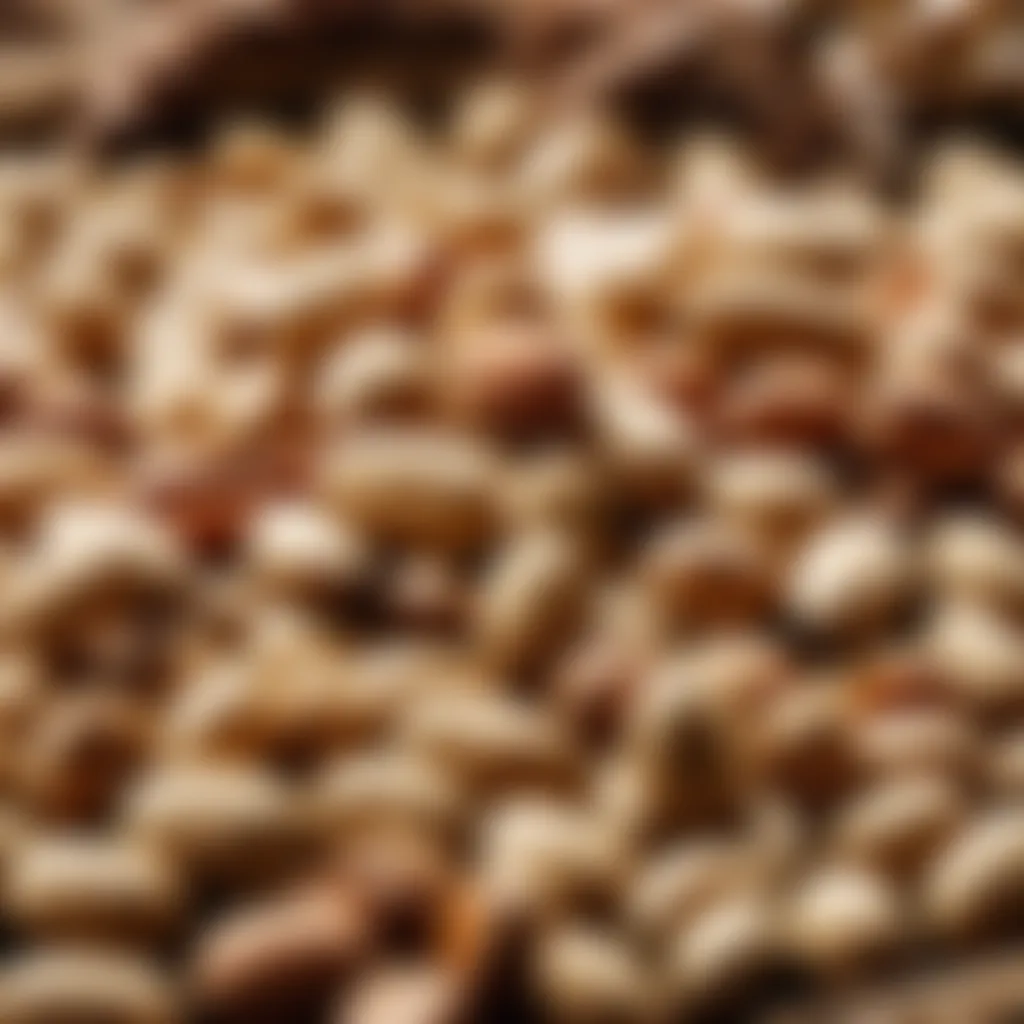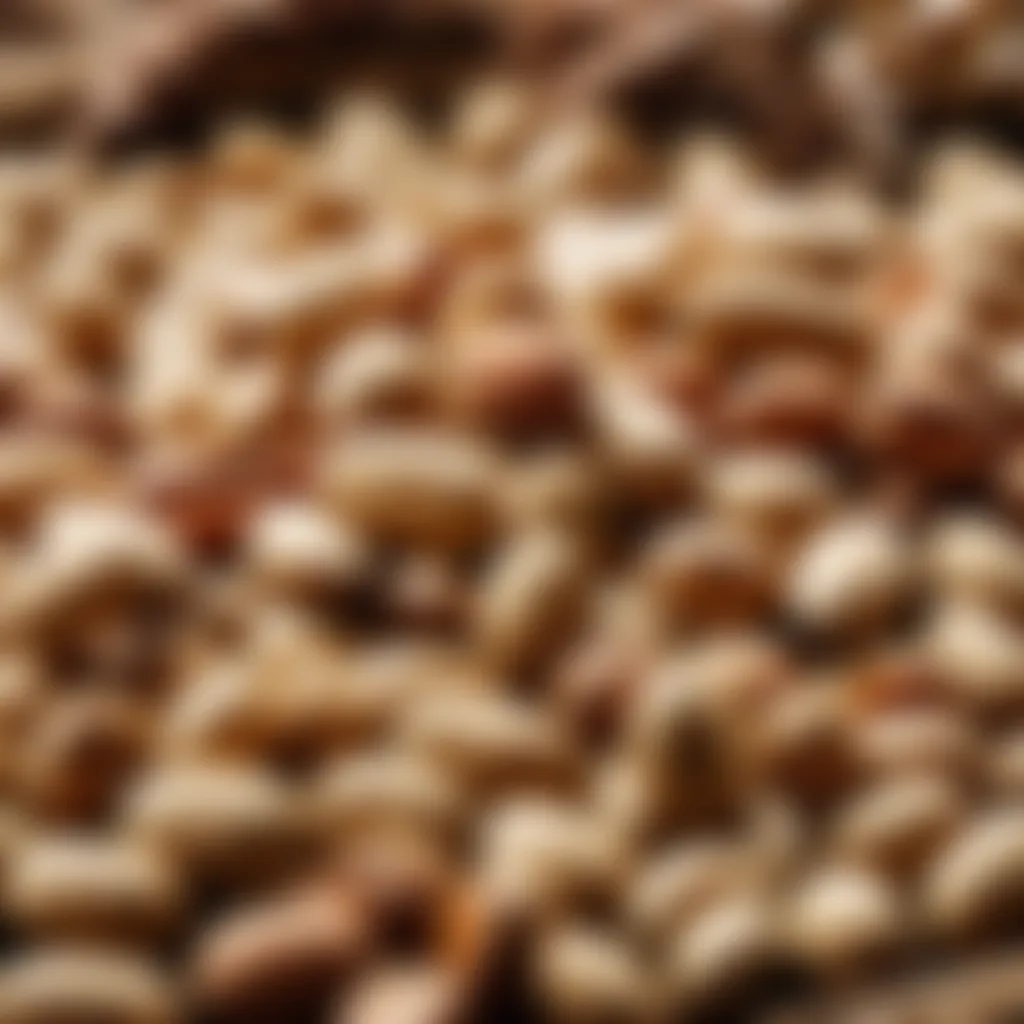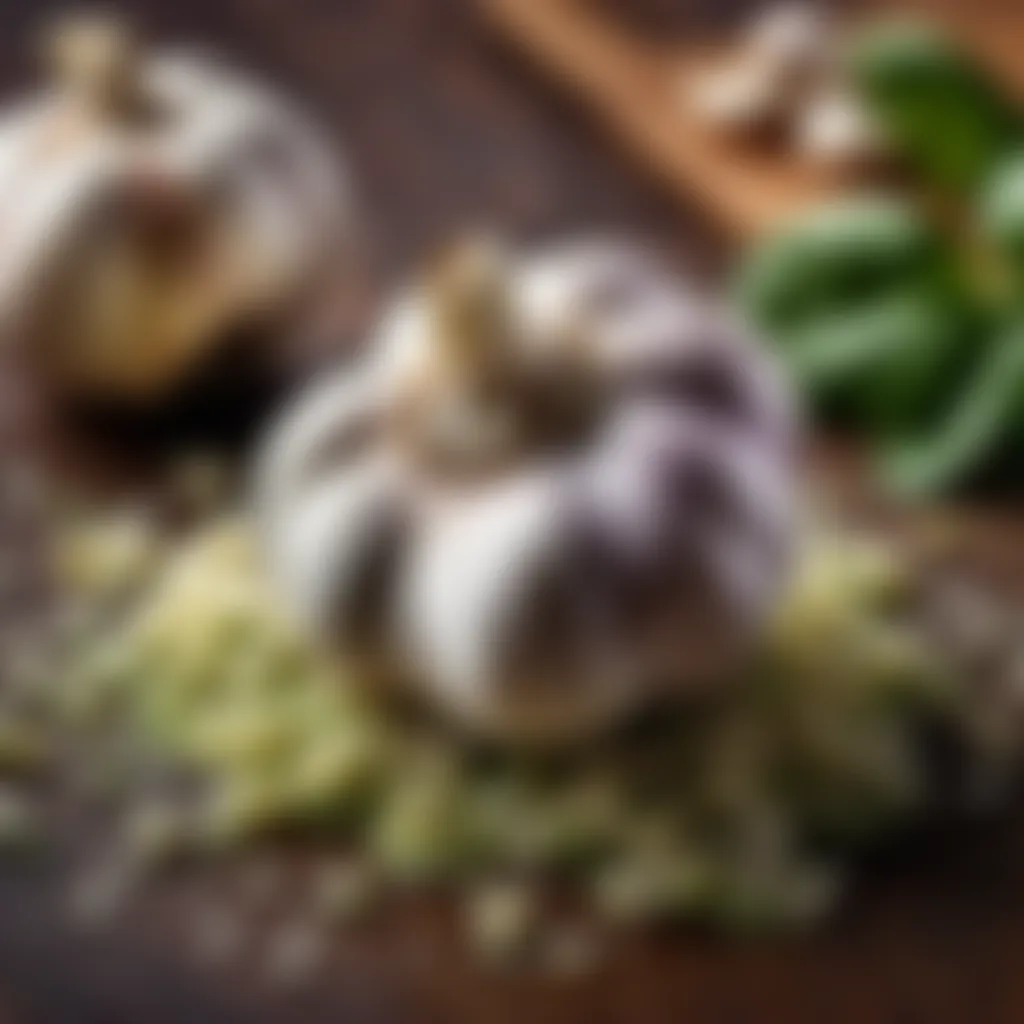Mastering the Art of Basil Pesto Preparation


Intro
Making basil pesto is both a culinary task and a delightful journey into flavor. This beautiful green sauce, originating from Genoa, Italy, has become a staple in kitchens around the world. It's versatile, packed with flavor, and surprisingly simple to put together. By carefully selecting your ingredients and following the right techniques, you can create a pesto that honors its rich heritage while also lending itself to personal twists. This guide will take you through every aspect, from gathering the right produce to savoring your creation.
Ingredients:
To kickstart your basil pesto adventure, here’s a well-curated list of all the ingredients you will need. Precision in these measurements can make a difference in achieving that perfect balance of flavors.
- Fresh Basil Leaves: 2 cups, tightly packed
- Pine Nuts: 1/3 cup
- Garlic Cloves: 2-3, peeled
- Parmesan Cheese: 1/2 cup, grated
- Olive Oil: 1/2 cup, extra virgin
- Salt: 1/2 teaspoon, or to taste
- Lemon Juice: 1 tablespoon, freshly squeezed (optional for brightness)
Keep in mind that using high-quality ingredients can significantly enhance the end result. When selecting basil, look for vibrant, healthy leaves without any dark spots.
Preparation Steps:
Detailed Instructions:
- Prepare the Basil: Rinse your fresh basil under cold water to remove any dirt or impurities. Gently pat dry with a paper towel or leave to air dry for a few minutes. This helps prevent excess water from diluting the flavors.
- Toast the Pine Nuts: In a dry skillet over medium heat, add the pine nuts. Stir them frequently for about 3-4 minutes until they turn golden brown. This step intensifies their flavor. Just be cautious as they can burn quickly.
- Combine Ingredients: In a food processor, combine the toasted pine nuts, garlic cloves, and salt. Pulse a few times until they are finely chopped. This creates the base for your pesto.
- Add Basil: Next, add the fresh basil leaves to the processor. Pulse again until mixed, but be careful not to over-blend at this stage. You want to maintain the basil's vibrant color and essence.
- Incorporate Cheese and Oil: Gradually add the grated Parmesan cheese, pulsing to combine. Then, with the processor running, slowly pour in the olive oil until the desired consistency is reached—smooth yet slightly textured, often described as a creamy paste. If you prefer, you can add lemon juice at this stage for added brightness.
- Adjust Seasoning: Taste your pesto and adjust the salt or oil as needed. If it’s too thick, a dash of warm water can help reach a smoother texture.
Technical Aspects:
Understanding the nuances of temperature and timing can elevate your pesto-making skills:
- Food Processor Speed: Use high speed for optimal blending of ingredients but switch to lower speed for incorporating the olive oil to control the texture.
- Ambient Temperature: Warm basil can lose its pungency, so work in a cool environment.
- Timing: The entire process should take around 10-15 minutes, depending on your familiarity with the technique.
Cooking Process:
Sequential Steps:
- For serving, consider enjoying the pesto over pasta, spread on a sandwich, or drizzled over grilled vegetables. The possibilities are endless.
- Leftover pesto can be stored in an airtight container in the fridge for up to a week. To prevent browning, drizzle a thin layer of olive oil on top before sealing.
Troubleshooting Tips:
Here are a few common issues and their solutions:
- Pesto is Too Bitter: Increase the amount of cheese or nuts to balance out the flavors.
- Consistency is Too Thick: Gradually add more olive oil or a splash of water until you reach the desired texture.
- Browning: If your basil turns brown, it might have been overheated during preparation. Always keep your tools cool, and avoid processing for too long.
Ultimately, making basil pesto should feel like a personal expression of culinary art, mixing tradition with your unique flair. So roll up your sleeves and get ready to blend flavors that sing!
A homestyle basil pesto isn’t just any ordinary sauce; it’s a statement, a reflection of culinary creativity, and delight in fresh ingredients.
Prologue to Basil Pesto
Basil pesto represents more than just a green sauce; it encapsulates centuries of culinary tradition rooted in the rich soils of Liguria, Italy. As we navigate the world of pesto, understanding its foundational elements offers a gateway into its flavorful and aromatic depths. Exploring why basil pesto deserves attention in your kitchen is more than a mere gastronomic exercise; it's about connecting with a cherished cultural heritage.
Historical Context
The origins of basil pesto stretch back to ancient times, with some food historians tracing its roots to the Roman dish moretum, a herb and cheese spread. However, the modern interpretation of basil pesto began to take its shape only in the 19th century. Liguria, with its warm Mediterranean climate and fertile lands, became the birthplace of this iconic sauce.
The term "pesto" derives from the Italian pestare, which translates to "to pound" or "to crush," reflecting the traditional method of preparation using a mortar and pestle. You wouldn’t believe how much effort and love went into each pestled batch back in the day! The combination of basil, garlic, pine nuts, cheese, and olive oil was intended to showcase the local ingredients and flavors, all while providing a way to preserve basil during the hotter months.
Pesto's journey from humble beginnings to an internationally beloved staple demonstrates the profound impact regional recipes can have as they cross borders and cultural barriers. Over time, various adaptations emerged, with ingredients changing based on available resources. This evolution highlights not only the creativity of cooks throughout history but also the adaptability of this sauce, making it a canvas for flavor exploration.
Cultural Significance
Basil pesto isn't merely a sauce—it's a symbol of Italian cuisine, reflecting the country's emphasis on quality, simplicity, and locality of ingredients. In Italian traditions, food serves as a way to bring people together, whether at a festive gathering or a quiet family meal. Pesto plays a role in many social occasions, often featured in pasta dishes, spread on bread, or used in antipasto platters. Its versatility allows for endless creative interpretations while still honoring the original recipe.
Moreover, pesto is often associated with the Ligurian way of life, where fresh produce dominates the culinary landscape. Here, the focus rests heavily on fresh, seasonal ingredients, elevating the dining experience without putting on airs. Invite your friends to a dinner showcasing this vibrant green sauce, and you'll find that it sparks conversations surrounding flavors, memories, and shared experiences.
What's fascinating about basil pesto is its ability to transcend boundaries—it has found its way into cuisine worldwide, from the kitchens of Napa Valley to Tokyo's bustling food scene. This adaptability speaks volumes about pesto's essence; it invites creativity while maintaining a sense of authenticity. So as you embark on your journey to crafting this delightful sauce, remember that you are participating in a long-standing tradition that continues to evolve and delight palates around the world.
Understanding Ingredients
When it comes to crafting basil pesto, diving into the ingredients is fundamental. Every component plays a critical role in defining the flavor profile and texture of the final sauce. Understanding these elements allows for better customization and enhances the overall experience of making and enjoying pesto.
Basil Varieties
Genovese Basil
Genovese basil stands as the crown jewel for many pesto aficionados. Its delicate leaves are characterized by a robust flavor, reminiscent of sweet, yet slightly peppery notes. This variety is not just a popular choice; it’s practically a staple when aiming for authenticity. The leaves have a tender texture that breaks down beautifully, lending a smoothness to the pesto that’s hard for substitutions to replicate. One significant advantage of Genovese basil is its aromatic profile. When bruised or chopped, it releases an intoxicating scent that embodies the spirit of Italian cuisine. However, a downside is that it is sensitive to temperature changes and wilts easily, often requiring careful handling to maintain its freshness.
Thai Basil
Thai basil offers a more adventurous spin on the classic recipe. With its hint of anise and a slightly spicier profile, it adds an exotic twist to the traditional pesto. The distinct flavor of Thai basil makes it an exciting option for those looking to shake things up a bit. It's commonly used in Southeast Asian dishes and can bring a unique fusion aspect to your pesto creation. The unique feature here is its resilience—it withstands heat better than its Genovese counterpart, making it ideal for cooked dishes. However, the flavor may not deliver the familiarity some prefer in traditional pesto, which can be seen as its main drawback.
Sweet Basil
Sweet basil is a versatile and widely recognized variety. Its bright, slightly minty flavor makes it an approachable choice for many culinary ventures, not just pesto. While it might not boast the strong flavor of Genovese or the spiciness of Thai basil, it brings a balanced and harmonious quality to the dish. The key aspect is its widespread availability and affordability, which make it a practical option for home cooks. However, being milder, it may require a larger quantity to achieve the desired level of basil flavor in a pesto. Sweet basil may thus lend itself to more mild sauces, which may or may not suit everyone's palate.
The Role of Garlic
Garlic serves as more than just an aromatic enhancement in pesto; it offers a punch of flavor and depth to the sauce that can’t be overlooked. When used correctly, garlic can elevate the freshness of the basil while also introducing a warm, earthy undertone. Yet, the key lies in balancing its intensity. Too much garlic can easily dominate the other flavors, overshadowing the basil's nature.
Oils and Their Impact


Olive Oil
Olive oil is often touted as a quintessential ingredient in pesto. Its rich, fruity flavor pairs exceedingly well with basil, allowing for a seamless integration of taste. Various kinds exist, from extra virgin to light oils, with extra virgin standing out for its superior flavor profile. The most significant characteristic is its high monounsaturated fat content, making it a heart-healthy choice. This oil enhances the pesto's creamy texture, creating a lovely consistency. However, one downside is that, depending on its quality, it can sometimes overpower the more delicate flavors of the herbs if not used sparingly.
Alternative Oils
For those seeking a different twist or with lactose intolerance, alternative oils can find a home in the pesto creation process. Oils like avocado or grapeseed provide unique flavors and maintain a smooth, creamy quality. One key benefit of alternatives is the ability to cater to varied dietary needs, appealing to a broader range of palates. The downside is, however, that these oils can lack the depth that traditional olive oil imparts, which can leave some purists wanting.
Nuts in Pesto
Pine Nuts
Pine nuts are often the go-to choice in authentic pesto. Their buttery, rich flavor melds beautifully with basil and cheese, delivering a distinctly creamy texture. The appeal lies in their nutritional profile as well; they are a great source of protein and healthy fats. But, despite their advantages, pine nuts come at a higher price point and can be challenging to source in some regions.
Walnuts
Walnuts are a more accessible nut option for pesto. While they bring a slightly bitter edge, their earthy flavor can add depth. A chief benefit of using walnuts is their affordability and availability; they also provide a robust texture that holds up nicely in the sauce. One downside is that their taste can overshadow the basil if not balanced correctly. Some might argue it leads the dish away from its traditional roots, which might not sit well with some purists.
Almonds
Almonds are yet another alternative that can lend a different flavor profile to the pesto. Using either sliced or blanched almonds introduces a lighter, more subtle nutty essence. Their major advantage relates to their versatility in culinary applications, being equally suitable for sweet or savory dishes. However, like walnuts, they can shift the traditional flavor balance if used too liberally.
Cheese Choices
Pecorino Romano
Pecorino Romano brings a sharp, tangy element to pesto, enhancing its complexity. This cheese provides a salty, savory kick and is well-respected in Italian cooking. It is a popular choice for many home cooks who want to elevate their pesto. However, it may not fit everyone's taste profile since the flavor can be quite pronounced, sometimes overwhelming the more delicate ingredients.
Parmesan
Parmesan is arguably the most mainstream cheese used in pesto. Its nutty flavor and granular texture make for a well-rounded addition. The benefit of Parmesan lies in its universal appeal, making it more approachable for those unfamiliar with pecorino Romano. Yet, while it’s a crowd-pleaser, it lacks some of the more robust characteristics of stronger cheeses, which may affect the complexity of the dish.
Nutritional Yeast
For those on plant-based diets, nutritional yeast offers an excellent cheese substitute, contributing a cheesy flavor without dairy. One standout feature is its nutritional profile, packed with vitamins and proteins. It can also provide a slightly nutty flavor that complements the other ingredients well. However, it may not replicate the creaminess of traditional cheese, which can alter the overall texture of the pesto.
Understanding the ingredients is foundational to creating a well-balanced and flavorful basil pesto. Selecting the right components allows for a unique interpretation of this classic sauce while maintaining its essential character.
Preparation Techniques
When it comes to making basil pesto, the techniques you employ can greatly influence the final product. Mastering these preparation methods is essential, as they can enhance the flavor and texture of your pesto, ultimately determining whether it’s as vibrant as a Mediterranean sunset or flat as a pancake. By understanding various preparation techniques, you can tailor the process to your skill level and personal taste preferences, making pesto more than just a recipe—it's an experience.
Traditional Methods
Using a Mortar and Pestle
Utilizing a mortar and pestle is a classic approach that embodies the artisanal spirit of pesto-making. This method allows for direct and precise control over the texture of the ingredients. The grinding action extracts the essential oils from the basil leaves, enhancing the aromatic qualities of the pesto. Because it’s a hands-on process, many cooks find a certain meditative rhythm in using a mortar and pestle.
However, it does require some elbow grease—there’s no way around it. While it might take more time and physical effort than using a food processor, the outcome is often described as richer and more nuanced. One of the unique features of this method is that you can easily adjust the consistency by choosing how finely to grind the ingredients. This personalization can be appealing for discerning palettes.
Emulating Traditional Textures
Emulating traditional textures in pesto is about achieving that authentic, rustic feel that comes from hand-ground ingredients. Many people prefer their pesto with a bit of a bite; they enjoy the rustic chunks of basil and nuts that can be lost in modern blending. This approach prioritizes not just flavor, but also the tactile experience of enjoying the sauce.
To achieve this without a mortar and pestle, cooks often opt for a technique that simply avoids over-processing in a blender or food processor. This method can be popular among those who appreciate texture in their dishes. The advantage here lies in its balance—it captures the essence of traditional preparation while accommodating contemporary cooking conveniences. Yet, it requires attentiveness to avoid turning the basil into a purée.
Modern Approaches
Food Processor Techniques
Shifting gears to modern approaches, food processors have opened up new avenues for speed and efficiency in pesto-making. With the push of a button, you can chop, blend, and emulsify your ingredients in a fraction of the time it takes with traditional methods. This approach is especially beneficial for busy home cooks who still want to enjoy fresh basil pesto without spending the entire afternoon at it.
The key characteristic of food processor techniques is consistency. If you prefer a velvety, uniform pesto, this method will suit you well. The downside, however, can be a loss of fine flavor nuances, as the high-speed blades can sometimes heat up the ingredients, altering their taste. Finding the right balance of speed and duration is crucial to maintaining that fresh basil flavor.
Customization through Blending
In today's culinary world, the emphasis on customization is more pronounced than ever. Customization through blending allows for more innovation in pesto recipes. Whether it's swapping out traditional pine nuts for something like sunflower seeds, or adding an unusual herb to the mix, the blending technique offers the flexibility to craft unique versions of pesto that reflect personal taste or dietary needs.
It’s also a great way to use up leftover ingredients in your kitchen. This unique feature makes it a hit among adventurous cooks. The only drawback might be the potential for creating a less cohesive flavor profile, especially if you’re experimenting with strong-tasting ingredients. A careful hand and a keen sense of taste can help mitigate this while maximizing your creative flair.
"The journey of making pesto is about balancing flavors and techniques to create something that speaks to you."
By exploring both traditional and modern preparation techniques, you open the door to endless possibilities. Each method has its own charm and challenges, enriching your culinary journey and allowing you to create a basil pesto that is truly your own.
Pesto Variations
When it comes to crafting basil pesto, variety is the spice of life. By exploring different takes on this classic, one unlocks endless possibilities that cater to diverse tastes and culinary traditions. Pesto variations highlight the adaptability of this sauce, showcasing how simple ingredients can transform based on regional influences and creative flair.
Customizing pesto allows for personal expression in the kitchen. Whether you opt for Sicilian twists or explore Mediterranean influences, each variation offers distinct flavors that can surprise even the most experience palates. The adaptable nature of pesto encourages experimentation, making it accessible to both novice cooks and seasoned chefs alike.
Regional Twists on Pesto
Sicilian Pesto
Sicilian pesto, or "Pesto alla Siciliana," often includes sun-dried tomatoes and almonds, diverging from the traditional basil, pine nuts, and garlic combination typically found in classic recipes. This is a refreshing option that emphasizes sweetness and a nuttier texture. Its unique characteristic lies in the addition of pecorino cheese, adding an earthy quality that complements the other ingredients.


Its adaptation makes it popular in areas where traditional pesto might not deliver the intensity desired. However, the distinct taste can overpower subtle dishes. Thus, those using Sicilian pesto should consider pairing it with robust meals, such as grilled vegetables or hearty pasta dishes.
Mediterranean Variations
Mediterranean variations of pesto span various cultures around the region. Combining fresh herbs like parsley and cilantro, olives, and even capers, these adaptations introduce a vibrant and aromatic character that is hard to resist.
The key feature of Mediterranean pesto is its eclectic mix of flavors. It upholds the vibrant taste of coastal cooking, opening avenues for creative culinary exploration. Many enjoy these variations for their bold taste that can jazz up a simple dish, such as a basic salad.
However, the wide array of ingredients might render the final dish unpredictably salty or sweet. As such, measuring each ingredient thoughtfully becomes essential to maintain balance when preparing Mediterranean pesto.
Innovative Ingredients
Sun-Dried Tomatoes
Incorporating sun-dried tomatoes into pesto not only adds depth but also imparts a unique tanginess that contrasts beautifully with the fresh elements of basil. These luscious bites infuse a rich and concentrated flavor, making them a compelling addition to the traditional pesto formula.
Their popularity in this article emerges from their ability to shift the flavor profile towards a more sophisticated palate while remaining remarkably straightforward to incorporate. However, it’s wise to keep an eye on portion size; too much can lead to overwhelming flavors, possibly masking the brightness of the basil.
Roasted Peppers
Roasted peppers can elevate a simple pesto into something truly transformative. Their slightly sweet, caramelized essence merges with the base flavors to create a luscious spread that works well on sandwiches or as a dip. The distinct characteristic of roasted peppers adds complexity, exposing a somewhat smoky side of pesto that can intrigue anyone exploring its uses.
While they can enhance texture, one must be cautious of the moisture content they bring to the mix. Balancing the amount of olive oil becomes imperative to avoid ending up with a watery compromise on your classic pesto.
Herbal Blends
Experimenting with herbal blends opens a treasure trove of flavors to infuse into pesto. Herbs such as cilantro, mint, or even oregano can bring about exciting twists, broadening the horizons of flavor in unexpected ways. These blends highlight the versatility of pesto as a canvas for showcasing a variety of herbs.
The benefit of using herbal blends lies in their ability to cater to personal preferences or garnish thematic dinners. However, one must note that some herbs can present strong flavors that overpower basil, requiring careful curation for a well-balanced outcome.
Flavor Chemistry in Pesto
Understanding the flavor chemistry in pesto is key to mastering this beloved sauce. It goes beyond mere taste; the flavors are a symphony that harmonizes to create an experience on your palate. When you mix the right ingredients in proper proportions, you create a balance that not only enhances the primary flavors but also brings out nuances that may go unnoticed. Essentially, it's about finding the sweet spot where all components sing together, providing both satisfaction and depth.
The Science of Balance
Creating the ideal pesto demands a keen understanding of balance. Each ingredient contributes a unique flavor profile, and it’s all about knowing how they interact. For instance, basil offers a fresh, peppery zest, while garlic adds a pungent bite. On the other hand, nuts like pine nuts or walnuts introduce a creamy richness, and cheese imparts a salty umami.
Here are some vital points to consider:
- Flavor Pairing: Use ingredients that complement and elevate one another. A pinch of salt can enhance sweetness, whereas acid from lemon juice can balance richness.
- Texture Matters: Texture plays a role in flavor perception. The creaminess from nuts and cheese, combined with the vibrant greens, creates a delightful experience that doesn’t just rely on taste but also on mouthfeel.
- Ingredient Proportions: It’s a balancing act. Too much garlic can overshadow the basil. If the cheese is heavy-handed, it may dominate the other elements. Therefore, start with smaller quantities and adjust as necessary to achieve that perfect blend.
Aromatic Compounds
Aromatics are crucial in pesto, contributing significantly to its distinctive aroma and flavor. These compounds are what hit the senses before even tasting, inviting you into the culinary delight
The importance of aromatic compounds in pesto includes:
- Volatile Oils: Basil is packed with compounds like linalool and eugenol, which give it that essential aromatic quality. When you crush the basil, it releases these oils, intensifying the fragrance and flavor.
- Garlic and Its Aromatics: Garlic contains compounds like allicin, known for its strong scent and health benefits. The act of pressing or chopping garlic releases these compounds, which then mingle with basil’s oils, creating a robust aroma that underscores the sauce.
- Layering Flavors: By incorporating nuts and cheese, you add complexity. Different types of cheese bring in varying flavors. For example, Pecorino Romano, with its sharpness, contrasts nicely with the sweetness of basil, while Parmesan lends a nutty depth. Together, they create aromatic harmony.
Pairing and Application
The section on pairing and application is crucial in mastering the art of basil pesto. Once you’ve created this vibrant green sauce, the next step is figuring out how to use it to elevate your dishes. It’s more than just a spread; basil pesto can tie various elements of a meal together, enhancing flavors and adding an aromatic depth that is nothing short of extraordinary. Understanding how to pair your pesto can lead to innovative culinary experiences.
Complementary Dishes
Pasta
Pasta is often seen as the classic partner to basil pesto, and for good reason. The smooth, creamy texture of the sauce clings to al dente noodles beautifully, creating a dish that feels hearty yet refreshing. The key characteristic is the adaptability of pasta; whether you prefer long strands like spaghetti or short shapes like penne, basil pesto can turn it into a savory masterpiece.
One unique feature of pasta dishes with pesto is the ability to incorporate seasonal vegetables. You can toss in vibrant cherry tomatoes or lightly steamed green beans, which adds color and nutrition to the plate. On the downside, if the pasta is overcooked, it can lead to a mushy texture, which can overshadow the fresh flavors of the pesto. Always aim for that perfect bite for an unforgettable meal.
Sandwiches
Sandwiches offer another exciting avenue for basil pesto application. The beauty of sandwiches lies in their versatility; from a simple deli meat sandwich to a gourmet panini, a spread of basil pesto adds a kick that heightens the entire experience. What distinguishes sandwiches is the layering of flavors and textures—crispy bread, melty cheese, and fresh veggies combined with the rich taste of the pesto creates a complex and satisfying bite.
Sandwiches also allow for creativity—experimenting with various ingredients means the opportunities are endless. However, one must be cautious with the amount of pesto added; too much can overpower other flavors. Striking the right balance is essential to ensure that every component shines.
Dips
Using basil pesto as a dip is a game-changer for gatherings or a casual snack. Its rich flavor profile makes it appealing as a tasty companion to veggies, crackers, or bread. The distinct feature here is its dual function; it can be enjoyed as a vibrant snack in addition to its role as a pasta sauce. This versatility is one of its significant advantages—it serves both as an appetizer and a meal enhancer.
Yet, it’s important to consider the consistency; if your pesto is too thick, it may not be very dippable. Adjusting with a touch of olive oil or lemon juice can help achieve a smooth texture, making it more palatable for dipping.
Beyond the Plate
Dressings
Basil pesto goes well beyond its traditional uses. When turned into a dressing, it offers a refreshing change to salads and roasted veggies. The herbaceous notes blend with acidity, making it a #1 choice for an invigorating salad dressing. It’s a quick way to elevate ordinary greens, coaxing out flavors that might otherwise lie dormant.
One particular advantage of using basil pesto as a dressing is its ease and speed—simply whisk together some pesto with a bit of vinegar or yogurt, and you’re ready. However, it’s best to ensure that the dressing doesn’t overpower delicate salad ingredients; a little goes a long way.
Marinades
When exploring marinades, basil pesto shines as a quality choice for meats and veggies alike. The marinade infuses the ingredients with flavor, making them succulent and aromatic. The nature of the oil and herbs in the pesto not only provides flavor but also tenderizes proteins, which is especially beneficial for tougher cuts of meat.


An advantage here is the time-saver aspect; no need for a lengthy marinating process—20 to 30 minutes is usually sufficient. Still, care must be taken not to use the marinade for basting while cooking, as it can introduce food safety concerns unless it's cooked down first or set aside separately.
Spreads
Lastly, basil pesto can transform ordinary spreads into something special. Whether you're looking to enhance cream cheese or add a punch to your butter, incorporating pesto provides that extra zing everyone craves. The inherent freshness of the herbs combined with a creamy base creates an enticing texture that is difficult to resist.
Yet, one must be cautious about pairing it with overly strong-flavored items. Too much competition can overwhelm the palate and detract from the enjoyment. Finding that perfect match, like a neutral-flavored bread or a light cracker, can make for a delightful snacking experience.
"Basil pesto is not merely a sauce; it’s a versatile tool that brings your culinary creativity to life, transforming ordinary meals into something extraordinary."
In summary, the pairing and application of basil pesto are essential to fully enjoying its potential in the culinary realm. Whether it's pasta, sandwiches, dips, or spreads, knowing how to integrate this flavorful sauce into various meals opens up a world of delicious possibilities.
Storing Pesto
When it comes to basil pesto, one might think the enjoyment ends once the last twirl of spaghetti shines green with that rich, herbal sauce. However, knowing how to store your pesto correctly means savoring that delightful moment long after the meal has finished. Storing pesto isn’t just about keeping food fresh; it’s about extending culinary joy. With the right techniques, you can ensure the flavors remain vibrant and the texture perfect for future use.
Short-Term Storage
After whipping up a fresh batch of basil pesto, it’s essential to plan for how to keep it edible for the upcoming days. Short-term storage can typically be accomplished in your fridge, allowing for easy access in case the craving strikes again.
- Container Choices: Choose an airtight container. Glass jars work well, as they help to maintain flavors without altering them. Be sure to leave a little room at the top, as pesto can cause pressure build-up if it’s too full.
- Layering with Oil: One clever trick is to drizzle a light layer of olive oil over the surface of the pesto. This oil acts as a barrier against air, which can oxidize the vibrant green hue and lead to browning. Nobody wants their beautifully crafted pesto to look like it’s seen better days.
- Use Within Days: In the fridge, basil pesto stays good for about a week. Use it within this timeframe to enjoy its fresh, lively flavors!
Long-Term Freezing Techniques
If you have made a larger batch of pesto or simply want to save some for the long haul, freezing it is definitely the way to go. Long-term freezing techniques can preserve the integrity and flavor of the sauce, making it a go-to for busy weeknights or surprise visitors.
- Ice Cube Trays: A nifty method is to fill ice cube trays with your pesto. Once frozen, transfer those cubes into a freezer bag or container. This way, you can easily pop out a cube or two whenever you need a burst of flavor in your dishes. Perfect for adding to soups or sauces!
- Labeling and Dating: Always mark your containers with the date. Pesto can last up to six months in the freezer, but keeping track helps ensure you use it while it’s still at its peak quality.
- Thawing with Care: When you’re ready to use your frozen pesto, avoid the microwave — it tends to change the texture. Instead, let it thaw gradually in the fridge overnight or toss the frozen block into a warm pot to gently heat through.
"Proper storage changes how you experience your food, making every bite as delightful as the first!"
Taking the time to understand how to store pesto appropriately doesn’t just prevent waste; it enhances your culinary experience, allowing you to enjoy this classic sauce whenever you please.
Nutritional Aspects
In the context of basil pesto, understanding its nutritional aspects holds significant importance for those looking to enhance their culinary repertoire while maintaining a balanced diet. Basil pesto is not just a delightful sauce but also a source of various nutrients that contribute positively to health. By dissecting the ingredients used in traditional basil pesto, we can uncover a wealth of health benefits that make it more than just a flavorful addition to meals.
Health Benefits of Ingredients
Each component of basil pesto brings its own unique set of nutrients and health benefits:
- Basil: This aromatic herb is rich in antioxidants, vitamins A, C, and K, which are crucial for maintaining healthy skin and supporting the immune system. Basil may also have anti-inflammatory properties, which can help reduce chronic inflammation in the body.
- Garlic: Known for its strong flavor and aroma, garlic is more than just a pleasing addition to pesto. It has been linked to numerous health benefits, including improved heart health, enhanced immune function, and potential antimicrobial effects. Garlic contains allicin, which may help lower blood pressure and cholesterol levels.
- Olive Oil: A key player in the Mediterranean diet, olive oil is a good source of healthy monounsaturated fats. It can promote heart health by lowering bad cholesterol levels and reducing the risk of coronary heart disease. Its antioxidant content, particularly vitamin E, contributes to skin health and cellular protection.
- Nuts (like pine nuts): These add a creamy texture and layer of flavor to pesto. They are packed with healthy fats, protein, and minerals like magnesium and zinc. Nuts can help in weight management as they keep you satiated and provide essential nutrients that support brain and heart health.
- Cheese (like Parmesan or Pecorino Romano): These cheeses contribute calcium and protein. Calcium is vital for bone health, while protein is essential for muscle repair and growth. The fermentation process used in cheese-making also adds beneficial probiotics that support gut health.
"Incorporating basil pesto into your meals is a delectable way to gain various nutrients while adding a burst of flavor."
Caloric Breakdown
When it comes to enjoying basil pesto, understanding its caloric makeup is essential for those monitoring their intake, be it for weight management or general health awareness. Here’s a rough breakdown of the calories derived from the main ingredients typically used in basil pesto:
- Basil: Low in calories, about 8 calories per 100 grams.
- Garlic: Around 149 calories per 100 grams, though most recipes use much less than this amount.
- Olive Oil: High in calories, containing about 884 calories per 100 grams. This is where the majority of the calories in pesto come from, primarily due to its high fat content.
- Nuts: Depending on the type, nuts can range from 600 to 700 calories per 100 grams. Pine nuts, notably, have about 673 calories per 100 grams.
- Cheese: For Parmesan, expect around 431 calories per 100 grams, while Pecorino Romano contains about 387 calories per 100 grams.
Given these elements, when prepared in moderation and balanced with other components in a meal, pesto can fit into a healthy diet. Understanding the caloric breakdown allows housewives to serve pesto thoughtfully, ensuring they enjoy its culinary richness without neglecting their dietary goals.
Ethical Considerations
In the culinary world, the choices we make extend far beyond the plate. When it comes to making basil pesto, it’s essential to consider the ethical implications of our ingredient sourcing and cooking practices. Understanding these aspects not only enhances the quality of our food but also contributes to a more sustainable future.
The creation of basil pesto, while a joyfully simple process, is grounded in a broader conversation about the ethical considerations that underpin modern cooking. Every ingredient we use has a story, and it's crucial to reflect on how those stories influence our environment and community.
Sourcing Ingredients Responsibly
When making basil pesto, sourcing ingredients responsibly becomes paramount. Let's break down what that means for each component in the recipe:
- Basil: Opting for locally grown basil supports local farmers and reduces carbon emissions associated with long-distance transport. Organic options can help minimize the use of pesticides that harm ecosystems.
- Cheese: Choosing cheese from dairy farms that practice humane animal husbandry not only benefits animal welfare but also improves the quality of the product. Look for labels that denote grass-fed or non-GMO feed.
- Nuts: Pine nuts, walnuts, or almonds should be sourced from suppliers committed to sustainable harvesting practices. Many forests, especially in regions like Italy, face deforestation; thus, it's crucial to purchase from vendors that uphold responsible harvesting standards.
- Oils: Extra virgin olive oil from sustainably managed orchards can make a significant difference. Consider brands that prioritize fair labor practices and environmental stewardship.
By being mindful of where our ingredients come from, we not only elevate our culinary experience but also contribute positively to the community and environment.
Sustainability in Cooking
Sustainability in cooking isn’t just a trendy phrase tossed around in foodie circles; it’s a necessary evolution in how we perceive and practice our day-to-day meals. As we whip up that delicious batch of basil pesto, thinking sustainably can shape our cooking habits and influence our choices in the kitchen. Here are some ways to adopt a more sustainable approach:
- Use What You Have: Instead of letting leftover herbs wilt and perish in the fridge, consider incorporating them into your pesto. This minimizes food waste and makes delicious use of ingredients already on hand.
- Preserve the Bounty: If you find basil at the local farmers' market for a steal, buy in bulk and preserve it through freezing or canning. Not only does this save money, but it allows for later enjoyment of peak-season flavors.
- Choose Seasonal Ingredients: Aligning your pesto-making with seasonal availability means you'll support local agriculture and enjoy fresher, tastier ingredients. This goes beyond basil to include cheeses and nuts that vary in availability.
- Repurpose Waste: Instead of simply tossing out scraps, find ways to utilize them. Basil stems can be used in stocks or blended into backyard compost, enriching your garden for future meals.
"Sustainability in cooking goes hand-in-hand with ethical considerations, shaping a culinary experience that nourishes not just the body but the planet."
In sum, embracing ethical considerations while preparing basil pesto is a small but impactful step towards making our everyday cooking practices more responsible. It fosters a connection between food, culture, and the environment, encouraging a holistic approach that every discerning home chef ought to embrace.
Epilogue
In concluding this exploration of basil pesto, it’s vital to appreciate not only the gastronomic delight it brings to our plates but also the rich historical and cultural story intertwined with its creation. Basil pesto is more than just a sauce; it's a culinary tradition that connects us to our roots, emphasizing the artistry involved in preparing food from scratch.
Reflections on Culinary Artistry
Every swirl of freshly made pesto is a testament to the skill and creativity in the kitchen. Crafting basil pesto invites us to embrace ingredients at their peak flavor and to celebrate regional nuances that can subtly alter taste perceptions. Each choice – from the type of basil to the selected nuts – speaks to our preparation style, whether it's embracing the old-world methods of using a mortar and pestle or opting for the efficiency of a food processor. The making of pesto serves as an opportunity for self-expression in the kitchen, merging tradition with innovation. Moreover, it fosters a sense of connection; sharing a bowl of homemade pesto with loved ones can create lasting memories and deepen relationships. The experience of crafting it fully embraces and encourages individuals to hone their unique culinary voice.
Encouragement for Experimentation
As you savor your basil pesto, remember that the art of cooking is an open canvas waiting for your personal touch. Don’t be afraid to dabble with different ingredients or to whip up a new variety to suit your palate. Perhaps a splash of lemon zest to brighten the flavor, or maybe you’re curious about the nutty elegance that pecans could bring? The beauty of making pesto lies in its adaptability.
Consider exploring variations like incorporating roasted garlic for a milder taste or using cilantro for a fresh twist. Experimenting with texture can also elevate your dish - add a bit of cream or Greek yogurt for creaminess or adjust the oil for a thicker consistency. This act of culinary exploration not only personalizes your pesto but also encourages a more profound appreciation for the flavors you've constructed.
In closing, allow your kitchen to be a place of creativity and fun, where every batch reflects your taste and style. With basil pesto as a firm foundation, the only limits are those you set. Dive in, explore, and most importantly, enjoy the delicious journey through the vibrant world of flavors.







